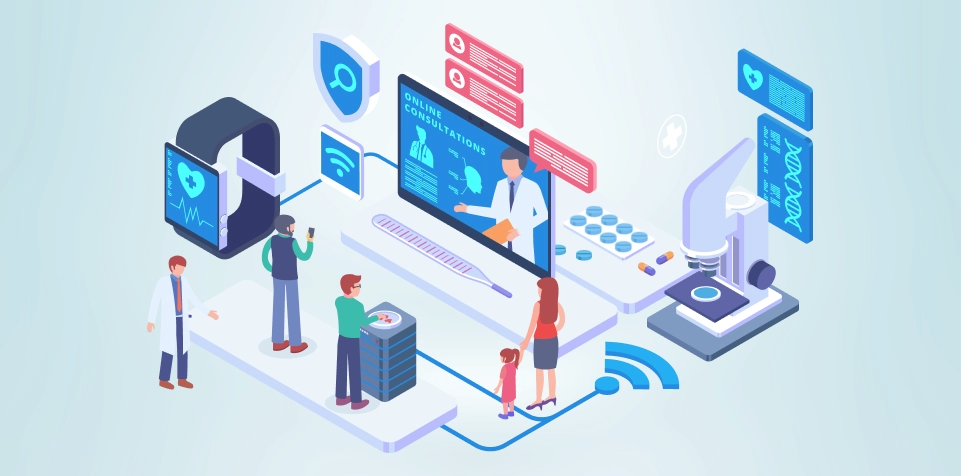Insights on Improvising Healthcare Services with Valuable Operational Data
July 3, 2023

Nowadays industries such as healthcare use advanced artificial intelligence and analytical tools to streamline business processes and provide personalized services to patients. This sector is experiencing a rapid revolution in the use of data.
Embracing a data-centric mindset in healthcare opens up a floodgate of opportunities. It has the potential to enhance the patient experience and enable personalized medicine. It also allows healthcare providers to shift from a reactive approach to a proactive one, leading to improved care. Additionally, utilizing data in healthcare creates opportunities to enhance the environment and optimize efficiency.
Knowing the power of data supremacy, the amount of data generated by healthcare organizations, ranging from patient information to clinical data, is astonishing.
While clinical data often takes center stage in digital transformation efforts, it is crucial not to overlook the significance of operational data. Operational data encompasses patient demographics, appointment scheduling, visit information, and billing data. This type of data provides valuable insights into healthcare operations and patient care.
This article delves into the importance of harnessing operational data to tackle various health and care challenges. With the usage of such efficient data, healthcare professionals can enhance care coordination, improve scheduling and capacity management, foster innovation, and more.
Research Done By Healthcare Setups
Healthcare organizations and research institutions want to enhance health and care by simplifying the tasks of healthcare teams and accelerating digital transformation, all while prioritizing the use of data.
When we talk about managing data for life and empowering organizations to take charge of their data, considerable effort is invested in working with intricate clinical datasets. These datasets encompass vital information like medications, diagnoses, and care plans, modeled using openEHR.
Healthcare organizations must deploy necessary strategies that can manage the process of data extraction and give meaning to the vast volumes of unstructured content. Additionally, there are various other crucial healthcare datasets, such as genomics data, imaging data, claims data, and clinical trials. Often customers seek help to solve the issues that arise with other important sets of data.

So what is Operational Data?
Information like demographics, visit information, scheduling appointments and billing is operational data. Specifically preserved in a structured format within the clinical and administrative systems, this data is accessed by very limited users. The secondary usage of this data is for performing analytics that is often done offline and is limited to the ability for proactive intervention.
Organizations are presently striving to bring a generational shift in healthcare delivery services. From EHR to a patient-centered view, healthcare setups now want systems that can support end-to-end patient issues across the entire healthcare industry.
And for that, there are innovative healthcare systems established in London building new patient-centered services such as shared care planning services. This particular service is now available across all five Integrated Care Systems. The said initiative has unlocked silos of clinical data and has established a vendor-neutral setup that caters to real-time data usage and harnesses its potential wherever needed across the regions.

Harnessing Similar Patterns to Unlock Operational Data
Based on the research done by various healthcare experts and scientists across the globe, it was found that harnessing similar patterns into operational data is quite possible. Let us discuss further why we should do this and what sort of problems can be solved by adopting such a view toward operational data.
Inadequate Coordination of Care
Imagine a scenario where a community or social care team is scheduled to visit a person’s home, only to find out that the person has recently been hospitalized due to a fall. Unfortunately, community and social care systems typically have no visibility of emergency admissions or related encounters. Having a centralized and reliable source of information that displays or alerts on emergency or acute admissions throughout the entire healthcare system could significantly reduce wasted visits and greatly improve the coordination of care.
Scheduling Without Effectiveness
The lack of shared information among different healthcare providers poses a challenge in identifying available resources and scheduling care efficiently. This limitation hampers the ability to promptly deliver care to those in need. However, there is a promising opportunity to practive predictive analytics and advanced AI models that enable resolving bottlenecks in care delivery before they occur.
Fragmented Capacity Management
During the COVID-19 pandemic, healthcare systems faced significant difficulties in obtaining accurate information on bed capacity in Intensive Care Units (ICUs). Some resorted to manual processes and cumbersome excel spreadsheets to share this vital information. With the implementation of cohesive and automated systems, healthcare providers can overcome this fragmentation and gain real-time visibility into bed availability, ensuring efficient utilization of resources during emergencies and beyond.
No Innovation and Proper Ecosystem
The absence of comprehensive information on patient activity poses a significant hurdle to innovation and the establishment of patient-centered ecosystems. To foster innovation and support the development of regional healthcare ecosystems, it is crucial to provide real-time access to patient information through dynamic dashboards, events, or open APIs. Such transparency can spur collaboration, enable novel approaches, and enhance overall healthcare services
Late Discharge and Blocking of Beds
A common challenge arises when medically fit individuals continue to occupy hospital beds due to a lack of awareness about available social care packages that match their needs. But when operational data is integrated from both health and care sectors, a robust platform can be established to address this issue and other similar use cases. This= integrated approach facilitates the efficient matching of individuals with appropriate social care resources, enabling timely discharges and minimizing bed blocking.
Existing systems may be available to customers to fulfill various requirements in terms of achieving population health management solutions or care records, but often this data remains locked and is not accessible to everyone.
Had this data been given in the hands of the right research and analytical team, they can:
- Transition from the traditional practice of exchanging operational data between systems by using HL7 v2 and observe a shift towards establishing a common repository of important information.
- Enable real-time streaming of capabilities that will permit healthcare providers to subscribe to those events, specifically patient cohorts or activities, ensuring stakeholders get updated and informed on the critical improvements leading to timely decision making.
- Separate data from applications and gain the flexibility to integrate existing solutions that are seamlessly the potential to create new data visualizations, BI reports, and AI models. This data decoupling will empower organizations to harness the best tools and technologies that can analyze and present information and can bring agility.
Presently, there are a set of healthcare groups in the world who utilize these advanced healthcare systems and by adopting this approach, they get enough benefits.
To give an example, Slovenia had issues with patient identity and operational data that were scattered across several systems and frequently unavailable or only partially accessible. As previously indicated, this circumstance led to problems with care coordination and ineffective scheduling. The Slovenian National eHealth project is now putting a federated operational repository into place to address these issues head-on. This repository will act as the nation’s consolidated and reliable source for data on patient demographics and ADT (Admission, Discharge, Transfer). The ultimate objective is to provide a solid base that permits the development of a modular ecosystem made up of linked apps. This ecosystem will deal with a variety of use cases, including both primary patient care and secondary data use.

Historically, operational data interchange entailed the difficult process of sending data across systems through HL7 ADT communications. Those who have implemented systems based on this method are familiar with the complexities and business logic required, even in smaller-scale deployments inside a single firm.
Many healthcare organizations nowadays are fully modifying this method to revolutionize it. In order to provide a single source of truth, we propose moving away from messaging and toward contemporary RESTful APIs that guarantee all data is kept in a vendor-neutral fashion. Depending on the needs, the data can either be spread across many supplier groups or consolidated.
Within the business, this architectural strategy can be scaled up and effectively shown in the field of clinical data. The only distinction is in the standards that may be chosen. Using FHIR for operational data while using openEHR for clinical data is the best practice. The same tested patterns—automated cloud-based deployment, ongoing security measures, elastic scalability, and high-performance capabilities—are used.

What happens when all this is combined with clinical data:
Moreover, by merging operational data with clinical data, healthcare providers can access a wealth of valuable insights into patient care. Leveraging the capabilities of openEHR, healthcare organizations can effectively model intricate clinical data encompassing medications, diagnoses, and care plans. Integrating this comprehensive clinical information with operational data allows for a holistic view of patient care.
Analyzing this merged dataset enables healthcare organizations to uncover patterns and trends that can significantly impact treatment decisions and ultimately enhance patient outcomes. This integrated approach also breaks down data silos, fostering improved collaboration among healthcare providers. As a result, patient care becomes more coordinated and cohesive, with multiple providers working together seamlessly to provide the best possible care.
Conclusion
Digital transformation efforts can only go effective if operational data is added to the system. This data can help you give enough insights to coordinate, schedule, innovate, and perform capacity management. To fully understand the capability of operational data various healthcare systems must break down silos and set up a vendor-neutral ecosystem that can provide real-time usage and can enable re-using of data across all regions.








